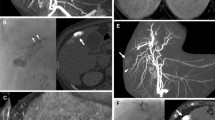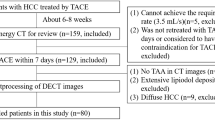Abstract
Purpose
To evaluate the sensitivity of dual-phase cone-beam computed tomography during hepatic arteriography (CBCTHA) for the detection of hepatocellular carcinoma (HCC) by comparing it with the diagnostic imaging “gold standard”: contrast-enhanced magnetic resonance imaging (CE-MRI) of the liver.
Materials and Methods
Eighty-eight HCC lesions (mean diameter 3.9 ± 3.3 cm) in 20 patients (13 men, mean age 61.4 years [range 50 to 80]), who sequentially underwent baseline diagnostic liver CE-MRI and then underwent early arterial- and delayed portal venous-phase CBCTHA during drug eluting-bead transarterial chemoembolization, were evaluated. Dual-phase CBCTHA findings of each tumor in terms of conspicuity were compared with standard CE-MR images and classified into three grades: optimal, suboptimal, and nondiagnostic.
Results
Seventy-seven (mean diameter 4.2 ± 3.4 cm [range 0.9 to 15.9]) (93.9%) of 82 tumors were detected. Sensitivity of arterial-phase (71.9%) was lower than that of venous-phase CBCTHA (86.6%) for the detection of HCC lesions. Of the 82 tumors, 33 (40.2%) and 52 (63.4%), 26 (31.7%) and 19 (23.2%), and 23 (28%) and 11 (13.4%) nodules were classed as optimal, suboptimal, and nondiagnostic on arterial- and venous-phase CBCTHA images, respectively. Seventeen (73.9%) of the 23 tumors that were not visible on arterial phase were detected on venous phase. Six (54.5%) of the 11 tumors that were not visible on venous phase were detected on arterial phase.
Conclusions
Dual-phase CBCTHA has sufficient image quality to detect the majority of HCC lesions compared with the imaging “gold standard”: CE-MRI of the liver. Moreover, dual-phase CBCTHA is more useful and reliable than single-phasic imaging to depict HCC nodules.



Similar content being viewed by others
References
El-Serag HB, Rudolph KL (2007) Hepatocellular carcinoma: epidemiology and molecular carcinogenesis. Gastroenterology 132:2557–2576
Takayasu K, Arii S, Ikai I et al (2006) Prospective cohort study of transarterial chemoembolization for unresectable hepatocellular carcinoma in 8510 patients. Gastroenterology 131:461–469
Mazzaferro V, Regalia E, Doci R et al (1996) Liver transplantation for the treatment of small hepatocellular carcinomas in patients with cirrhosis. N Engl J Med 334:693–699
Yamashita Y, Mitsuzaki K, Yi T et al (1996) Small hepatocellular carcinoma in patients with chronic liver damage: prospective comparison of detection with dynamic MR imaging and helical CT of the whole liver. Radiology 200:79–84
Llovet JM, Real MI, Montana X et al (2002) Barcelona Liver Cancer Group. Arterial embolisation or chemoembolisation versus symptomatic treatment in patients with unresectable hepatocellular carcinoma: a randomised controlled trial. Lancet 359:1734–1739
Lo CM, Ngan H, Tso WK et al (2002) Randomized controlled trial of transarterial lipiodol chemoembolization for unresectable hepatocellular carcinoma. Hepatology 35:1164–1171
Llovet JM, Bruix J (2003) Systematic review of randomized trials for unresectable hepatocellular carcinoma: chemoembolization improves survival. Hepatology 37:429–442
Miyayama S, Matsui O, Yamashiro M et al (2009) Detection of hepatocellular carcinoma by CT during arterial portography using a cone-beam CT technology: comparison with conventional CTAP. Abdom Imaging 34:502–506
Kakeda S, Korogi Y, Ohnari N et al (2007) Usefulness of cone-beam CT with flat panel detectors in conjunction with catheter angiography for transcatheter arterial embolization. J Vasc Interv Radiol 18:1508–1516
Miyayama S, Yamashiro M, Okuda M et al (2009) Usefulness of cone-beam computed tomography during ultraselective transcatheter arterial chemoembolization for small hepatocellular carcinomas that cannot be demonstrated on angiography. Cardiovasc Intervent Radiol 32:255–264
Meyer BC, Frericks BB, Voges M et al (2008) Visualization of hypervascular liver lesions during TACE: Comparison of angiographic C-arm CT and MDCT. AJR Am J Roentgenol 190:W263–W269
Lin M, Loffroy R, Noordhoek N, et al. (2010) Evaluating tumors in transcatheter arterial chemoembolization (TACE) using dual-phase cone-beam CT. Minim Invasive Ther Allied Technol [Epub ahead of print]
Feldkamp LA, Davis LC, Kress JW (1984) Practical cone-beam algorithm. J Opthalmol Soc Am A 1:612–619
Wallace MJ (2007) C-arm computed tomography for guiding hepatic vascular interventions. Tech Vasc Interv Radiol 10:79–86
Wallace MJ, Kuo MD, Glaiberman C, Binkert CA, Orth RC, Soulez G (2008) Three-dimensional C-arm cone-beam CT: applications in the interventional suite. J Vasc Interv Radiol 19:799–813
Hirota S, Nakao N, Yamamoto S et al (2006) Cone-beam CT with flat-panel-detector digital angiography system: Early experience in abdominal interventional procedures. Cardiovasc Intervent Radiol 29:1034–1038
Orth RC, Wallace MJ, Kuo MD (2008) C-arm cone-beam CT: general principles and technical considerations for use in interventional radiology. J Vasc Interv Radiol 19:814–821
Georgiades CS, Hong K, Geschwind JF et al (2007) Adjunctive use of C-arm CT may eliminate technical failure in adrenal vein sampling. J Vasc Interv Radiol 18:1102–1105
Deschamps F, Solomon SB, Thornton RH, et al. (2010, April 14) Computed analysis of three-dimensional cone-beam computed tomography angiography for determination of tumor-feeding vessels during chemoembolization of liver tumor: A pilot study. Cardiovasc Intervent Radiol [Epub ahead of print]
Miyayama S, Yamashiro M, Okuda M, Yoshie Y, Nakashima Y, Ikeno H et al (2011) Detection of corona enhancement of hypervascular hepatocellular carcinoma by C-arm dual-phase cone-beam CT during hepatic arteriography. Cardiovasc Intervent Radiol 34(1):81–86
Matsui O, Takashima T, Kadoya M et al (1985) Dynamic computed tomography during arterial portography: the most sensitive examination for small hepatocellular carcinomas. J Comput Assist Tomogr 9:19–24
Matsui O, Kadoya M, Kameyama T et al (1991) Benign and malignant nodules in cirrhotic livers: distinction based on blood supply. Radiology 178:493–497
Matsui O, Ueda K, Kobayashi S et al (2002) Intra- and perinodular hemodynamics of hepatocellular carcinoma: CT observation during intra-arterial contrast injection. Abdom Imaging 27:147–156
Racadio J, Yoshizumi T, Toncheva G, Stueve D, Anderson-Evans C, Frush D (2008) Radiation dosimetry evaluation of C-arm cone beam CT for pediatric interventional radiology procedures: a comparison with MDCT. RSNA, Chicago, IL
Acknowledgments
This study was funded by the French Society of Radiology and supported by a Grant from Philips Research North America, Briarcliff Manor, NY.
Conflict of Interest
The authors declare that they have no conflict of interest.
Author information
Authors and Affiliations
Corresponding author
Rights and permissions
About this article
Cite this article
Loffroy, R., Lin, M., Rao, P. et al. Comparing the Detectability of Hepatocellular Carcinoma by C-Arm Dual-Phase Cone-Beam Computed Tomography During Hepatic Arteriography With Conventional Contrast-Enhanced Magnetic Resonance Imaging. Cardiovasc Intervent Radiol 35, 97–104 (2012). https://doi.org/10.1007/s00270-011-0118-x
Received:
Accepted:
Published:
Issue Date:
DOI: https://doi.org/10.1007/s00270-011-0118-x




